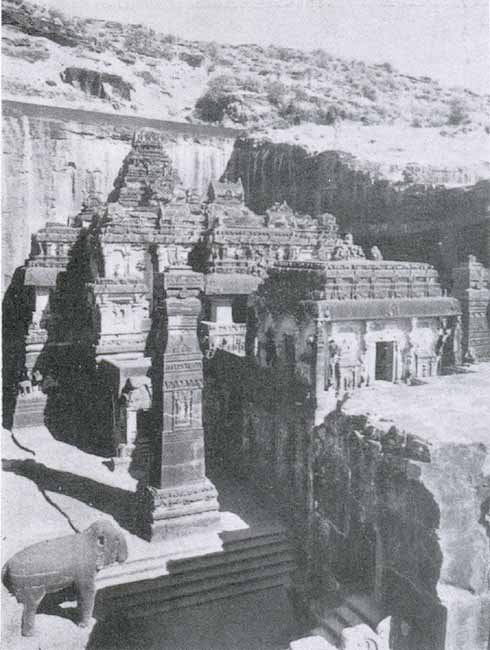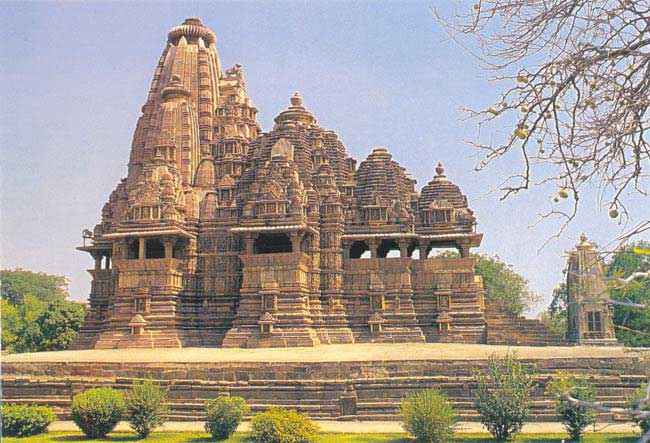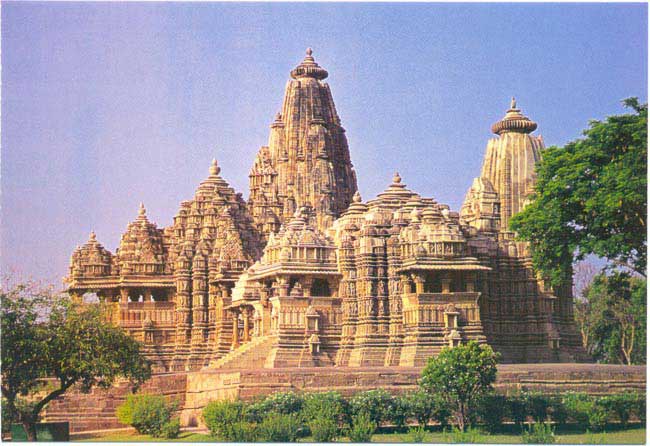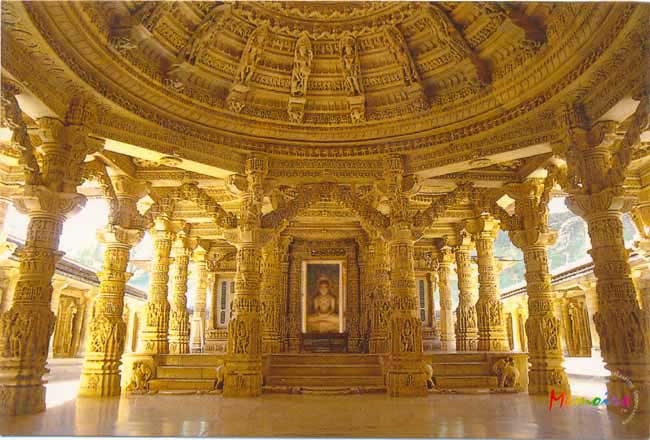
|
|
RAJPUT ARCHITECTURE
The Rajput Rulers had a keen sense of beauty in Art and Architecture which is seen in the artistic excellence of their temples, forts and palaces. The Indo-Aryan style of architecture developed in North India and Upper Deccan and the Dravidian style in South India during the Rajput period. Both sculpture and architecture attained a high degree of excellence.
The Rathas of Mahabalipuram or Mamallapuram, the Kailash temple at Ellora and the sculpture of Elephanta belonging to the early Rajput period (600 AD to 900 AD)

Kailash Temple, Ellora
(Picture courtesy Archaeological Survey of India)
The temple architecture of Orissa, Khajuraho, Rajasthan, Madhya Pradesh and the Pallava, Chola and Hoysala temples in the South belong to the later Rajput period. (900 A.D. to 1200 A.D.)
The significant feature of the North Indian (Indo-Aryan) style of temple architecture are the “Vimana” or sanctuary, the “Garbha Griha” or the small dark cell where the main idol is placed, the Shikhara - a ribbed curvilinear spire over the Garbha Griha, the Amalaka or round stone on the Shikhara surmounted by a golden Kalasa. Every temple had a Sabha mandap which was used by devotees for group meditation, religious discourses etc., Examples of this type are the Vishwanath and the Khandariya Mahadeva Temples, the Khajuraho temples, the Surya Temple at Konark, the Lingaraj temple at Bhubaneshwar, the Jagannath Temple in Puri and the Tejpala Temple at Mt. Abu.
The Khajuraho Temple at Bundelkhand (the present Chatarpur district of Madhya Pradesh) were constructed by the Chandela ruler of Jejabhukti between 950 A.D. and 1050 A.D. About twenty five temples in all, these belong to the Shaiva, Vaishnava , and Jain sects. Beautifully sculptured, there is no difference in architectural style in the different temples to distinguish one religion from the other.
The Kandriya Mahadeva temple and the temple of Vishwanath belong to the Shaiva group, the Chaturbhuja temple to the Vaihnava group and the Parswanath temple to the Jain group.
The Khajuraho temples are built of pink buff-coloured and light yellow fine grained sand-stone. Architectural beauty reaches its highest peak in these temples. The temple are compact and are erected on a high platform terrace. The temple have an entrance porch, a mandap or hall, a vestibule and the Garbha-Griha or sanctorum. The larger temples have space around the Garhha-Griha for purpose. of pradakshin. (or circumambulation) with a projecting balcony window on either aide and at the back giving it the shape of a cross with two long arms. The balcony window which have a canopy of overhanging eaves are the most attractive features of the Khajuraho temples. The temple has an Adhishtana or base which has beautiful mouldings. These hold the platform terrace. The space between them is taken up by very gracefu11y carved alternate projections and recessives. The central part of the temple or Janegha are the roofs of the several inner compartments rising gradually, one higher than the other - the one over the Garbha-Griha being the highest. The graded peaks being so arranged that they look like a mountain range. The structure over the entrance porch and mandapa are pyramidal in shape but the Shikhara over the sanctum is tall and curvilinear. Entrance to the temple is through the entrance porch which has a Makara Torana flanked by crocodiles. The torana has minute figures carved on it. The doorways, pillars and ceilings are all profusely carved with floral and geometrical designs. The bracket figures of Apsaras, bhutas and ganas are masterpieces of sculpture.
The Vishwanatha Temple was built by the Chandela king , Dhanga in 1002 A.D. and has all the features of the Khajuraho temple. It enshrines a Shiva Linga.

Visvanatha Temple, Khajuraho
(Picture courtesy Archaeological Survey of India)
The Khandariya Mahadeva Temple also enshrining a linga is the largest monument of Khajuraho. It is 30.5 m in length and height and 20 m in width. It was built between 1017 AD. – 1029 AD. in the reign of Vidyadhara Chandela. Though similar to the Vishwanath temple in plan, it is a magnificent piece of architectural skill with a series of graded and ascending shikharas – 84 in all, it presents a picture of architectural excellence. Its lofty basement has sculptured friezes of elephants, horses, hunters, dancers, musicians etc. The erotic figures on its outer walls show the influence of Tantrism. The interior design of this temple is like that of any other Khajuraho temple though it is larger and more lavishly sculptured.

Khandariya Mahadev & Jagadambi Temple, Khajuraho
(Picture courtesy Archaeological Survey of India)
The Parswanatha temple built in 950-70 AD dedicated to the first Jain Tirthankara is the finest and largest of Jain temples in Khajuraho. It is rectangular and has axial projections in the front and back. The entrance porch has a highly ornamental ceiling embellished with floral and chain patterns. The sanctum, a vestibule and mahamandapa are other features of the temple and contain figures of Jinas. A particular feature of this temple is that Vaishnava themes are more dominant in the sculptures such as those of Rama, Sita, Hanuman and Parasurama. Beautiful figures of Sura-Sundaris in various poses adorn the walls. The sikhara of the temple has three rows of scu1ptural bands on the outer facade.
Architecture reached a high degree of artistic excellence in the 11th and 12th century AD. during the rule of the Chalukyas as seen in their Jain temples at Girnar and Palitana in Gujarat.
Palitana, the city of temples, lies at the base of the Shatrunjaya Hill and near the Shatrunjaya river and is about 600 metres above sea level. One of the sacred hills of the Jains, there are more than eight hundred Jain shrines on it. The temples built of marble and stone are marvels of architecture. The most important of these is the temple of Shri Rushabha Dev, the first Tirthankara of the Jains. Another famous temple is the Chaumukh or four faced temple dedicated to Adinath built in the 16th, century. The temple has four entrances. The main entrance leads to the assembly hall.
The storey above has balconied windows. Jain scriptures engraved on marble slabs adorn the temple walls. A flight of steps leads to these temples. This conglomeration of temples look like a setting of ivory miniatures.
The 11th century Jain temples at Mount Abu in Rajasthan built by the ministers of the Solanki rulers show the heights of perfection reached the artists of that time.

Dilwara Jain Temple, Mount Abu, Rajasthan
The Dilwara Jain Temples, famous for architectural beauty, were built about 1088 AD during the reign of Vimalasah. Constructed in white marble, these temples were built to a set plan on a high platform, a cell enshrining a deity surrounded by a walled courtyard. Around the courtyard are other shrines with images of Jain tirthankaras. The two temples here of note are the Vimalavasahi temple dedicated to Adinatha, the Jain titthankara and the Tejpala temple with its intricately ornamental ceiling and white marble halls displaying delicate architecture. The circular design with spokes of finely sculptured figures on pedestals at the bases of which are other figures in a sitting posture add to the grandeur of the ceiling.
|
|